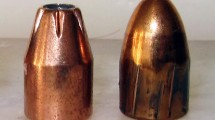Abstract
By measuring the total crack lengths (TCL) along a gunshot wound channel simulated in ordnance gelatine, one can calculate the energy transferred by a projectile to the surrounding tissue along its course. Visual quantitative TCL analysis of cut slices in ordnance gelatine blocks is unreliable due to the poor visibility of cracks and the likely introduction of secondary cracks resulting from slicing. Furthermore, gelatine TCL patterns are difficult to preserve because of the deterioration of the internal structures of gelatine with age and the tendency of gelatine to decompose. By contrast, using computed tomography (CT) software for TCL analysis in gelatine, cracks on 1-cm thick slices can be easily detected, measured and preserved. In this, experiment CT TCL analyses were applied to gunshots fired into gelatine blocks by three different ammunition types (9-mm Luger full metal jacket, .44 Remington Magnum semi-jacketed hollow point and 7.62 × 51 RWS Cone-Point). The resulting TCL curves reflected the three projectiles’ capacity to transfer energy to the surrounding tissue very accurately and showed clearly the typical energy transfer differences. We believe that CT is a useful tool in evaluating gunshot wound profiles using the TCL method and is indeed superior to conventional methods applying physical slicing of the gelatine.






Similar content being viewed by others
References
Rutty GN, Boyce P, Robinson CE, Jeffery AJ, Morgan B (2008) The role of computed tomography in terminal ballistic analysis. Int J Legal Med 122:1–5
Grosse Perdekamp M, Vennemann B, Kneubuehl BP, Uhl M, Treier M, Braunwarth R, Pollak S (2008) Effect of shortening the barrel in contact shots from rifles and shotguns. Int J Legal Med 122:81–85
Fackler ML, Malinowski JA (1985) The wound profile: a visual method for quantifying gunshot wound components. J Trauma 25(6):522–529
Korac Z, Kelenc D, Baskot A, Mikulic D, Hancevic J (2001) Substitute ellipse of the permanent cavity in gelatin blocks and debridement of gunshot wounds. Mil Med 166:689–694
Korac Z, Kelenc D, Hancevic J, Baskot A, Mikulic D (2002) The application of computed tomography in the analysis of permanent cavity: a new method in terminal ballistics. Acta Clin Croat 41:205–209
Thali MJ, Kneubuehl BP, Vock P, Allmen G, Dirnhofer R (2002) High-speed documented experimental gunshot to a skull-brain model and radiologic virtual autopsy. Am J Forensic Med Pathol 23:223–228
Gawlick H, Knappworst J (1975) Zielballistische Untersuchungsmethoden an Jagdbüchsengeschossen. Ballistisches Laboratorium für Munition der Dynamit Nobel AG, Werk Stadeln
Ragsdale BD, Josselson A (1988) Predicting temporary cavity size from radial fissure measurements in ordnance gelatin. J Trauma 28(1 Suppl):S5–S9
Kneubuehl BP (2008) Simulanzien. In: Kneubuehl BP, Coupland R, Rothschild M, Thali MJ (eds) Wundballistik- Grundlagen und Anwendungen, 3rd edn. Springer, Berlin, p 147
Schyma CW (2010) Colour contrast in ballistic gelatine. Forensic Sci Int 197:114–118
Rutishauser H (1976) Vorlesungen über numerische Mathematik, Band I, Birkhäuser-Verlag, Basel und Stuttgart
Acknowledgments
The authors wish to thank the Science and Technology Division, Armasuisse, Ministry of Defence, Switzerland for conducting test shots to the gelatine blocks.
Conflict of interest
No conflict of interest.
Author information
Authors and Affiliations
Corresponding author
Rights and permissions
About this article
Cite this article
Bolliger, S.A., Thali, M.J., Bolliger, M.J. et al. Gunshot energy transfer profile in ballistic gelatine, determined with computed tomography using the total crack length method. Int J Legal Med 124, 613–616 (2010). https://doi.org/10.1007/s00414-010-0503-z
Received:
Accepted:
Published:
Issue Date:
DOI: https://doi.org/10.1007/s00414-010-0503-z




